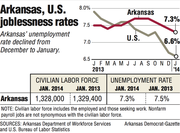Arkansas’ unemployment rate has improved consistently since August, on the basis of revised research, the U.S. Bureau of Labor Statistics said Monday.
The state’s unemployment rate fell to 7.3 percent in January from 7.4 percent in December. The rate has fallen from 7.7 percent in August.
The national unemployment rate was 6.6 percent in January and 6.7 percent in February.
Monday’s report was relatively positive, said Michael Pakko, chief economist at the Institute for Economic Advancement at the University of Arkansas at Little Rock.
“The emerging trends since August last year have been improving,” Pakko said.
Employment has increased monthly since August, from 1,222,800 to 1,231,200 in January. And the number of unemployed has declined since August, from about 102,000 to 96,800 in January.
Before revisions for 2012 and 2013 were announced Monday, it had been reported that the unemployment rate in August was 7.4 percent.
The revision in employment data shows that there actually was “notable weakness in Arkansas’ labor markets” in 2012 and 2013, Pakko said.
“The unemployment rate was stuck at 7.5 percent or higher for pretty much all of 2012 and most of 2013 [the revisions showed],” Pakko said. “At one point [before the revision] it looked like Arkansas’ unemployment rate had dropped close to 7 percent.”
The revisions are made in March each year by the Bureau of Labor Statistics.
“All of the employment numbers, of course, are not counted like the census count,” said Kathy Deck, director of the Center for Business and Economic Research at the University of Arkansas at Fayetteville. “They are based upon statistical models. Within the state, [in one survey] they sample the state’s employers. What they know is it is a lot easier to talk with [employers] who have been around for a while than it is to catch the new employers, for example.
“So every March, they [update] the data with the latest information they have from the census, and the latest information they have about what the real universe of employers looks like. They go back several years to make sure that the data are consistent with the newest information.”
Looking at the revised numbers, Arkansas remains about 20,000 jobs behind the employment level measured before the recession began in December 2007, Deck said.
“You would hope that we would be making a lot quicker progress back toward that pre-recession peak,” Deck said.
Arkansas’ economy has added only 28,300 jobs since the recession ended in June 2009, said Greg Kaza, executive director of the Arkansas Policy Foundation, a conservative research group in Little Rock. That is only about 500 jobs a month over the 55 months.
The state’s unemployment rate has declined only slightly, from 7.6 percent to 7.3 percent, over that same period, Kaza said.
The revisions indicate there are fewer jobs in Arkansas’ metropolitan areas, compared with earlier estimates, Deck said.
“Some things that had looked like gains last month look a lot flatter now,” Deck said.
For example, Deck said, the revisions showed that Northwest Arkansas and central Arkansas each had about 10,000 fewer jobs in the past two years than in earlier estimates. Those jobs were not lost; the total was just recalculated, Deck said.
The good news from the revised decline in jobs in the metropolitan areas is that rural areas are doing better than had been thought, Deck said.
“Even though the rural areas continue to lag, now it doesn’t look quite as terrible,” Deck said. “So maybe the rural areas are holding their own a little bit better.”
Seven industry sectors in the state have added jobs since January last year and four have lost jobs.
The biggest jump in jobs was in the leisure and hospitality sector, which added 4,200 jobs.
But possibly the most significant gain was 1,200 more jobs in construction over the 12-month period, Pakko said.
“The construction sector was particularly hard hit in this recession because the nature of the recession was the collapse in the housing market,” Pakko said. “Typically, construction has been one of the leading indicators of improvement in the economy. But we’re just seeing tentative signs of improvement there. It may not be lasting.”
The state’s manufacturing sector recorded the biggest decline in jobs since January last year with 1,600 lost.
Rhode Island had the highest unemployment rate in the country in January at 9.2 percent, followed by Nevada and Illinois at 8.7 percent each, California at 8.1 percent and Michigan at 7.8 percent.
North Dakota had the lowest unemployment rate at 2.6 percent, followed by Nebraska at 3.5 percent, South Dakota at 3.6 percent, Utah at 3.9 percent and Vermont at 4 percent.
Front Section, Pages 1 on 03/18/2014
